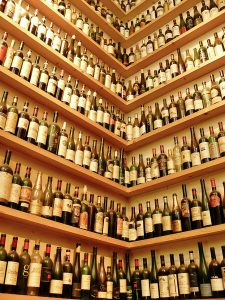Happy Thanksgiving tomorrow. At this late date, it is likely your wine for the great American harvest feast is set. Some notes about serving it.
Almost all red wines, and some whites, rosé, and sparklings, benefit from decanting. But which ones and for how long?
• Light-body reds (pinot noir, gamay)—20-30 minutes.
• Medium-body reds (merlot, grenache, zinfandel, malbec, tempranillo, cabernet franc, sangiovese, barbera)—30-60 minutes.
• Full-body reds (cabernet sauvignon, petit sirah, mourvèdre, tannat, nebbiolo, touriga nacional)—60-plus minutes.
• Whites and rosés do not need to be decanted unless there was not enough oxygen during the making for certain molecules to combine. That situation is called “reduction” and is identified by the smell of burnt match, sulfur, rotten eggs. Although reduction sounds terrible, there is an easy cure—exposure to air. Which is what decanting does. It usually takes less than 15 minutes in a decanter or in your glass.
• Sparkling wines rarely need to be decanted, but they, too, sometimes suffer from reduction. The cure is the same. Counterintuitively, decanting does not noticeably reduce the bubbles.
There are some wines you should not decant, or decant with extreme caution. Old wines usually are delicate and decay quickly after opening. You can decant to avoid sediment, but you should enjoy old wine soon after opening. Prosecco should not be decanted because its bubbles will fade. Delicate white wines—those with aromas of grapefruit, guava, passionfruit—may lose their signature aromas. Sauvignon blanc is a prime example.
The type of decanter matters. The suggestions above are for the standard decanter, ones with a wide base to create a large surface area for wine to interact with oxygen. Other decanters combine aeration, exposing the wine to air during the pouring from the bottle into the decanter, and often in the re-filling the original bottle from the decanter. They reduce decanting time.
If you have not purchased your wine yet, here are some suggestions.
Tasting notes:
• Cono Sur Sparkling Brut, Bío Bío Valley, Chile NV: Simple wine, simply tasty. $10-12 Link to my review
• Stoller Family Estate Pinot Noir Willamette Valley 2019: Delightfully elegant, restrained, with an engaging touch of forest floor. $24-32 Link to my review
• Sanford Pinot Noir, Sta. Rita Hills 2019: Seductively demure presentation of cool-climate pinot noir from historic vineyard. $38-45 Link to my review
Last round: If things go wrong with Thanksgiving tomorrow, don’t lose your head. The turkey already did that for you. By the second glass of wine, what do you care?


